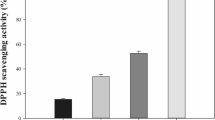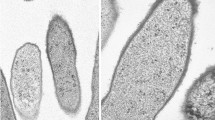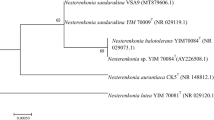Abstract
In the process of cultivating Rhodobater sphaeroides R26.1, some of which turned from blue to pink due to the irradiation of a beam of leaking white light. The mutant strains were named ‘pinky’ strains, which were cultivated in the red light and in the dark for a comparative study. It turned out that the strains did not grow in the dark, so they might be photosynthetic bacteria. The electronic absorption spectrum of the ‘pinky’ strains was measured, which shows they contained two main photosynthetic pigments, carotenoids(Cars) and bacteriochlorophylls(BChls). And then they were extracted and analyzed. It proves that Bchls included Bchl a and Bchl a′. Nuclear magnetic resonance (NMR) spectra were exploited to determine the chemical structure of Cars. The results indicate that there were seven kinds of Cars, including lycopene, rhodopin, anhydrorhodovibrin, 3,4-dihydroanhydrorhodovibrin, 3,3,4-dihydrospirilloxanthin, 3,4,3′,4′-tetrahydrospirilloxanthin and spirilloxanthin. Based on the above results, it was found that most identified Cars formed via spirilloxanthin biosynthesis pathway. The analyzed results of 16S rRNA gene show that the homology of ‘pinky’ strains with Rhodopseudomonas palusteris was 99%. Rhodopseudomonas palusteris has been cultivated in our laboratory. Because of its strong vitality, it did not become extinct with so many years passing. When Rhodobater sphaeroides R26.1 was cultivated, it got rejuvenated under the appropriate conditions and caused Rhodobater sphaeroides R26.1 to be contaminated.
Similar content being viewed by others
References
Rodney A. H., Andrew G., Takashi M., Richard J. C., Bruno R., Shinichi T., Stephanie S., Photosynthesis Research, 2008, 95(2), 261
Keiko O., Toshio K., Akira H., International Journal of Systematic and Evolutionary Microbiology, 2009, 59(3), 531
Maneewan S., Wanna C., Jill H. Z. R., Poonsuk P., Biotechnology Letters, 2010, 32(11), 1667
Hiseni A., Arends W. C. E. I., Otten G. L., Appl. Microbiol. Biotechnol., 2011, 91(2), 1029
Fernandes P., Int. J. Mol. Sci., 2010, 11(4), 858
Frank H. A., Cogdell R. J., Photosynthesis Research, 1993, 25(3), 252
Frank H. A., Violette C. A., Trautmen J. K., Pure Appl. Chem., 1991, 63(1), 109
Rzeznicka K., Schatzle S., Bottcher D., Klein J., Bornscheuer U. T., Appl. Microbiol. Biotechnol., 2010, 85(4), 1417
Tretiak S., Middleton C., Chernyak V., J. Phys. Chem. B, 2000, 104(3), 9540
Gradinaruc C., Kennis J. T., Papagiannakis E., PNAS, 2001, 98(5), 2364
Takaiehi S., Shimada K., Ishidsu J., Arch. Microbiol., 1990, 153(2), 118
Li Z., Chun G. Z., Da X. H., Biotechnol. Lett., 2011, 33(2), 2135
Hirschberg J., Currt. Opin. Plant Biol., 2001, 4(1), 210
Yuen K. Y., Woo P. C. Y., Teng J. L. L., Leung K. W., Wong M. K. M., Lau S. K. P., J. Clin. Microbiol., 2001, 39(4), 4227
Englert G.; Eds.: Britton G., Liaaen-Jensen S., Pfander H., NMR Spectroscopy in Carotenoids, Vol. 1B, Brikhauser, Basel, Switerland, 1995
Sandmann G., Trends Plant Sci., 2001, 6(1), 14
Britton G., Photosynthesis Research, 1998, 96(4), 141
Grnewald K., Hagen C., J. Applied Phycol., 2001, 13(2), 89
Author information
Authors and Affiliations
Corresponding author
Rights and permissions
About this article
Cite this article
Pan, Y., Xie, J., Koyama, Y. et al. Characterization of ‘pinky’ strain grown in culture of Rhodobacter sphaeroides R26.1. Chem. Res. Chin. Univ. 29, 506–511 (2013). https://doi.org/10.1007/s40242-013-2318-1
Received:
Accepted:
Published:
Issue Date:
DOI: https://doi.org/10.1007/s40242-013-2318-1




